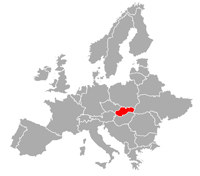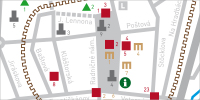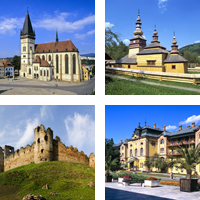                            |
The prevailing architectonic styles in Bardejovské Kúpele represent classical style and Art Nouveau. The most significant buildings like Colonnade, Spa House, Ozón hotel, and other works of modern architecture beautifully embedded in the spa environment. The whole area has wonderful parks with many contemporary and historical works of art.
The oldest preserved building in Bardejovské Kúpele is Tahy dvor from 1777. At the end the of 18th century, the spa village grew significantly bigger and turned into planned urban unit solely dedicated to spa treatment and socio-cultural events. Villa Rákóczi, which currently contains an exhibition of Šariš Museum, was also built at the end of the 18th century.
At the beginning of 19th century, the spa was ranked among the most renowned in the Austro-Hungarian Empire. Many important noble families had their residences and mansions there. A period record says that: “The Spa looks like a lovely town with elegant buildings, clean environment and air filled with ozone. The nobility competed in building luxurious houses.”
The city of Bardejov even built a luxurious casino for its guests. The historian Csaplovics described it in 1817: “It consists of one round saloon that is held up by six columns and is delicately painted. The interior consits of luxurious chandeliers, mirrors, cut glass sets, and artistically decorated gallery.” The casino would become legendary and the Spa earned its right to be called “Small Monte Carlo”.
The classicist Church of the Elevation of the Holy Cross was built in 1821, followed by first therapeutic house built in 1834. The Spa had quickly blossomed in the first half of the 19th century when it suddenly started to decline. Some buildings were destroyed in the revolutionary years of 1848 and 1849, while the rest of them fell victim to deadly fire in 1856. Fortunately, the town council put effort into gradual restoration and further development of Bardejovské Kúpele in the late 19th and early 20th century.
|
Railway to Bardejov was finished in the 19th century. The objects that did not fit functionally or aesthetically into Spa environment would be removed from the area. A local brook was also adjusted at that time.
The neoclassicist Deák hotel (nowadays known as Alžbeta hotel) was finished in 1893, and it was the first one from three big Spa houses. Its left wing served in 1895 as an accommodation for Empress Elizabeth, known as Sissi. Meanwhile, another exquisite building was erected –Széchényi hotel, (nowadays known as Dukla). It was built in the historicist style, with the use of Neo-Baroque decorations and wooden elements of so-called “Swiss style”.
The monumental classicist palace with Art Nouveau decoration – Spa House Alžbeta, was built in 1897 in the central zone of the Spa. This architectonical masterpiece of world importance, now known as Astória hotel, is the dominant feature of Bardejovské Kúpele.
The concert pavilion and electric lighting were added up at the end of the 19th century. The oldest spa park in Slovakia, which was built as early as the first half of the 18thcentury, was enlarged and adjusted to its new surroundings. Many Art Nouveau-styled villas were built along the new circuit. It was also where the legendary New York Casino, famous for numerous affairs and tragedies, could be found. The casino fell victim to fire in 1951 and was replaced by Mier hotel.
The inhabitants of Bardejov decided to build a statue of Empress Elizabeth in 1903. It was made by a renowned academic sculptor from Budapest, Professor Donáth, and situated in the Spa Park. Even though the empress was in her sunset years, in her farewell speech she thanked everyone around and added that she felt like she was eighteen after drinking from the healing springs. Hence the fresh look of the statue that resembles an eighteen-year-old girl.
|
Up until 1910 the spa used to offer almost 2000 rooms, high-quality gastronomy, cafes, playgrounds, shops and a post office. The city brimmed with social events. Dance parties and chamber music concerts would take place every week, along with gypsy music playing at the promenade. The turn of the century marks the most successful period for Bardejovské Kúpele. Nevertheless, the upcoming World War I precipitated decline of the spa.
Further development of spa took place in the interwar period. Some modern buildings and facilities like amphitheatre and summer swimming pool were built, together with the monument to fallen Russian soldiers. One of the most important events concerning the preservation of cultural heritage was a dismantling of small church in Mikulášová village and its reassembling in Bardejovské Kúpele.
With the arrival of socialism after World War II, the Spa was nationalized and the process of transformation to up-to-date medical-recreation facility could start. Buildings with higher architectonical importance were preserved, while many other were tore down. A pompous reconstruction started with Colonnade with a music pavilion (1972), which was the first building of its kind in Slovakia. Parks were decorated with modern architectonical and art pieces, while neighboring woods were fitted with rehabilitation paths. Buildings like Spa House (1974), Ozón hotel (1976), Žriedlo Cinema (1977), or Shopping and services centre (1983) followed.
In Bardejovské Kúpele, a walk through splendid parks and forest trails is an essential must-do experience. The Spa Park smoothly flows into forest park with benches, shelters, or fireplaces, and later it turns into forest. In the relax area of Spa there is the oldest museum of folk architecture in Slovakia.
Translated by:
Mgr. Tomáš Fedorko
Juraj Šott, M.A.
|













